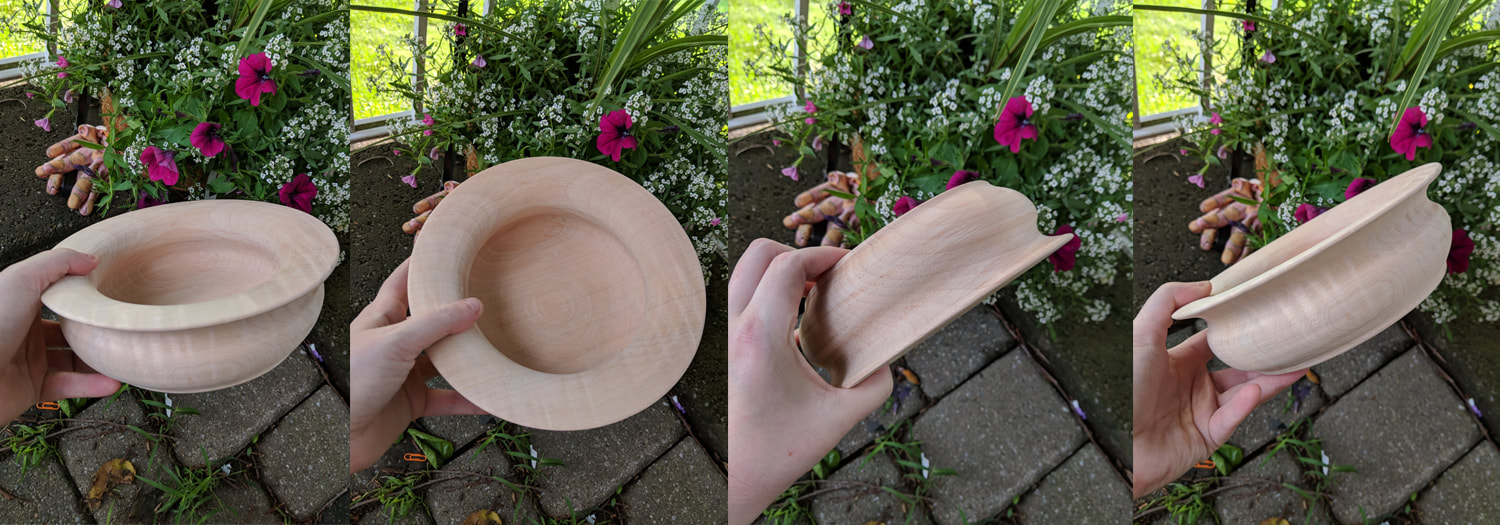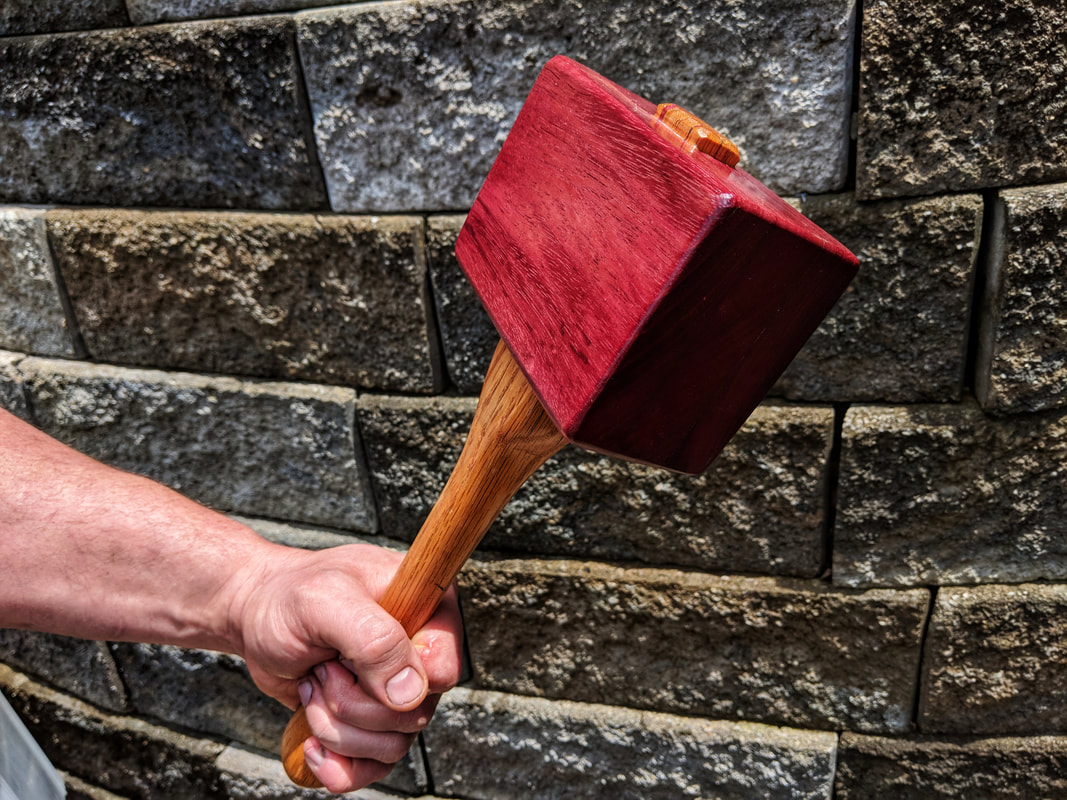|
Last week I talked a little bit about starting a new hobby or process with the fact that I might have no idea what I am doing and using that as a mantra when I feel stuck or insecure about having to ask for help. This week let's talk about how Ben ordained me as a woodworker after my first bowl turning experience and how I applied previous knowledge of other processes into practice when trying a new skill.
Ben put a lot of time into getting the Lathe functional for us after it sat on the floor in the basement for a seemingly ridiculous period of time - at least for his aggressively ambitious wife here. For our 8 year anniversary, we gifted each other a set of Easy Wood Tools Carbides for our anniversary gift to each other. (How romantic, right?) I had done a good bit of research prior to even putting any wood on the lathe. I read up on what all of the different parts of the lathe were for, how to adjust them and made sure I knew how to hold my tools properly. The first object I practiced on was a piece of pine, just to get the feel for the tools and shake off any fears I might have had about combining a spinning block of wood and sharp tools. Happily I discovered that it's not that far off from trimming pots on the wheel. Same general rules applied; a steady hand, a general plan of the shape, confidence with tool placement and angle, don't press too hard, keep your tool sharp. The pine was not a friendly wood to start out with, so, we took a trip to woodcraft on Sunday and picked up some bowl blanks. Figured Maple to be specific for all of you wood junkies. I remember when I first started trimming pots on my wheel, my nervousness about messing up my hard earned pot made me overly cautious and actually resulted in me marring my pieces or rushing to try to get to trimming meant I didn't fully recenter my pot on the wheel or the clay was too soft to avoid warping the shape. My steadiness wasn't the greatest and my perception was also a bit off as well. I had a hard time identifying by look and feel how thick my walls were and how much material I could actually remove from my base. It was frustrating at first but like anything the more you do it - the better you are. Eventually, I got much better at tapping my pieces to recenter them on the bat. I gained confidence in my tool placement. I learned what tools to use and how to keep them sharp enough. I learned when in the drying process was the best time to actually trim a piece. Spending the time to learn how to properly trim didn't just enhance my pottery skills, but definitely gave me a better understanding for the mechanics of turning wood on a lathe. This applied knowledge definitely lent itself to a successful first bowl. Similar to trimming pieces, I had to center and recenter due to using a faceplate and not a chuck. This is one area that I can imagine myself trying to do without my previous knowledge and probably getting very frustrated out the gate. I've become very used to the flanged bowl shape that I decided to turn it on the lathe for my first bowl. I throw basic shaped bowls and not to completely knock them, I find them a bit visually boring and I really was't interested in making a wooden one. I hadn't even thought that it would be that difficult to turn one. It wasn't until I started sharing what the outside looked like that I started getting feedback that maybe I bit off more than I could chew. I didn't feel overly challenged or nervous about the form, I'm comfortable with how it looks and how it should feel, I know where I need to push into the material to move it the way that I need and where I need a more gentle touch to avoid collapsing or breaking the vessel. I hadn't even though that the choice of vessel was really advanced or complex. I realize now though, that shape felt effortless to me because I have spent a lot of time with that form on the wheel. I love the look of the base and the drastic curves, the thin rim allows to showcase a surface plane for glaze or, now, wood grain. The form itself is applied knowledge. However, not everything came easy. There are a few things that are much different than what I'm used to. Like the fact that the vessel has to be securely attached to the lathe, much more than your lump of clay and you thrown piece. For Pottery, you use water and suction to get your clay to initially attach to your wheel. You use the pressure of your weight to command the piece to center before you start to form your walls. When you are ready to trim you tap the piece to center and then use small amounts of clay to secure it back onto the bat to trim. With the Lathe, I had to use a faceplate and screw it into the face of the blank. It's not perfectly round, so it's not perfectly centered when you do finally mount it to the lathe. It can be a bit intimidating when you have a light lathe and it's rattling and bucking and thowing your sharp tool about. When you turn it over to start hollowing the piece out you have to recenter your bowl and either glue it to a sacrificial base or you have to screw the faceplate into your base. I tried the glue up method first: 
I giggle when I'm scared, upset, angry, happy, sad...it's my go to reaction. Valuable lesson learned in the first attempt - always wear proper PPE. After I got my composure back I found shallow screws and hesitantly screwed the faceplate back to the center of the bowl itself. The challenge with this is that unlike pottery, I now had to consider how deep the screws were into the base and try my best not to get too close to hitting them with my tool. The other thing that was a challenge were the leftover screw holes in the mouth of the bowl. I wasn't ready for how much they were going to be grabbing my tool and after my piece came off initially I was a bit gun shy. The other notable difference is that with Pottery, you don't really have anything in your way to position yourself to see inside your piece or any hinderance for applying your tool. If your lathe is short, your tail stock can make things challenging. I found myself getting a bit irritated as I was trying to round over the inside and angle my tool into the belly of the bowl, my elbow or the back of my tool would get caught up on the tail stock. (I think we need a bigger boat.) The other thing that was a bit of a challenge was that if you get tool chatter on a pot, you can just wet a sponge and work out the marks or you can burnish your piece. With wood, you either have to lightly remove the marks with your tool or sand for days. I'm sure as I get better, my tool marks and tear out will be less apparent - but it's definitely a difference.
There are some better things that the Lathe offers that my wheel does not. For instance, the banjo and tool rest are really nice to help steady my hand and my tool. I don't have to just use my physique to steady it. It helps guide it straight as well so my take away is much more even as I glide the tool across the surface. A process improvement with turning is that I can start and finish a bowl in the same day. Pottery is long and arduous in the journey to a finished piece. I love it, but if I were more in need of proof of my days efforts...turning might be a better option. Future for me with turning looks like this - upgrade to a chuck if I'm going to turn more bowls, I want to get into segmented turning, I want to try my hand at dyes like John Clothier uses. I want to live a dusty life now! I definitely will be following through with combining the mediums together in some way in the near future. I have some sketches and I'm so excited to see where I'll go with it. When looking at things you do, where do the lines blur from one practice/craft/trade to another? Have you benefited from applying one skillset into another? AuthorHeidi Jacobs is the Co-Founder of Slap Stuff Together, a maker's studio. She is also a Project Manager by day and part time professional photographer. If you would like to learn more about SST's adventures as a new start up you can follow them on Instagram or on Facebook. If you would like to learn more about their startup you can drop them a line at [email protected]
0 Comments
Leave a Reply. |
HEIDI JACOBSSmall Business owner and Artist, committed to growing as a maker as well as sharing her and her husband's experience with owning a small maker studio. Archives
June 2019
SEE ALL CLICK |

 RSS Feed
RSS Feed
